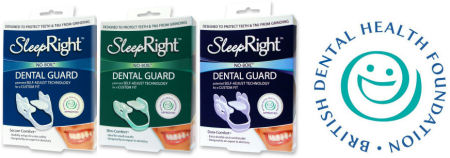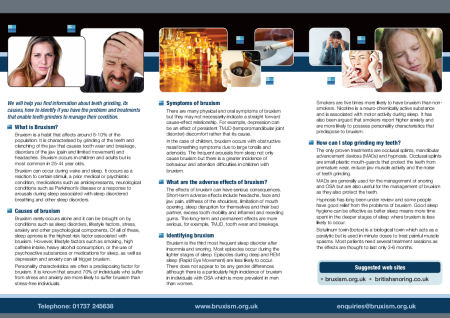Bruxism is reported in about 20% of children up to the age of 11 years, although this is probably an underestimate as the condition is sometimes unnoticed by parents. As with adults, there are many causes of bruxism but in children symptoms are similar to other conditions and may be overlooked or misdiagnosed.
Teeth grinding causes nocturnal arousals and is classified as a sleep disorder, however it is also a response to nocturnal arousals that are associated with other sleep disorders. It is a very common complaint of children with mouth breathing, adenotonsillar hypertrophy, obstructive sleep apnoea (OSA), dental occlusion and psycholgical problems. It is also linked to craniomandibular disorders including headaches and temporomandibular joint discomfort.
The consequences of teeth grinding in children are often manifested in behavioural problems due to the constant nocturnal arousals. Research has found that children with bruxism have a tendency towards anxiety, stress and hyperactivity. It is also strongly associated with Attention Deficit Hyperactivity Disorder (ADHD). An interesting study found that behavioural problems and bruxism in children were linked to maternal depression. The increased arousals and behavioural problems in children were significantly correlated with parents who reported psychological or physical complaints.
Episodes of bruxism last around 4 seconds and occur approximately 6 times per hour. They tend to occur in clusters throughout the night with the majority in Stage 2 and REM sleep. One study found that 60% of bruxism episodes were accompanied by arousal. Forty percent of the children in this study had reported clinically significant attention or behaviour problems.
It is often difficult to determine whether bruxism is the cause of increased arousals and attention and behaviour problems, or if children with attention and behavioural difficulties exhibit altered sleep together with bruxism. However, it is known that sleep fragmentation secondary to sleep disordered breathing in children can lead to behaviour, attention and executive function problems.
There is a correlation between bruxism and upper airway obstruction. Tonsillar hyperplasia (enlarged tonsils) is one of the most common causes of sleep disordered breathing. The enlarged tonsils and/or adenoids obstruct the airway and can lead to OSA. Mouth breathing is a common feature in these children. It is thought that arousals during sleep lead to an increase in jaw, teeth and masticatory (chewing) activity. Children with airway obstruction tend to pull the jaw forward to mechanically keep the airway open. This action may stimulate receptors in the upper airway to increase airway muscle tone, leading to bruxism. Snoring and mouth breathing are very common symptoms in children and are often considered to be of minor importance by parents. Because of this, a diagnosis of OSA can be delayed by several years.
A study comparing the incidence of bruxism before and after adenotonsillectomy in children with upper airway obstruction, found that all children had at least 75% airway obstruction prior to surgery. Three months after surgery disturbed breathing had been resolved in all children and there had been a significant reduction in bruxism, although 24% maintained the habit of mouth breathing.
Would you like to receive our most current information and offers by e-mail? Enter your e-mail address here to sign up.

The SleepRight dental guards are the only occlusal splints approved by the British Dental Health Foundation. Find out more.

If you would like us to provide your surgery with our information leaflets, please complete the on-line request form.
Do you need more information for your article or you want to organise an interview? Contact our media desk.

Introducing the world's leading oral appliance for bruxism, snoring and sleep apnoea. Read more.